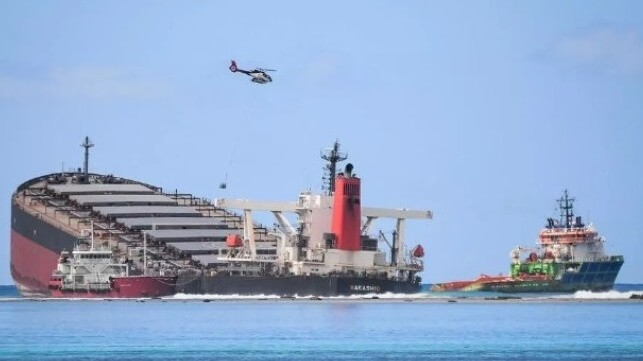JTSB: Wakashio Went Aground Because Crew Sought Cell Coverage

After three years, the Japan Transport Safety Board has completed it investigation into the devastating grounding of the bulker Wakashio off Mauritius. The stricken vessel spilled about 1,000 tonnes of fuel oil into the water near a protected lagoon, prompting an extensive cleanup effort. According to the JTSB, the accident occurred because the crew - who lacked satcom access on board - had transited too close to the coastline in an attempt to pick up cell phone coverage.
In July 2020, the cargo ship Wakashio was under way in the Indian Ocean, bound southwest on a voyage to Tubaran Port, Brazil. On July 23, the master ordered its course changed to bring it within five nautical miles of the island so that the crew could connect to terrestrial cell reception. According to JTSB, the crew had previously approached the coast of Mauritius (and other nations) repeatedly for this purpose. In this instance, the captain did not order detailed marine charts for the coastal waters where the ship would navigate. Charts of the appropriate scale would have revealed that the water depth along this stretch of the coast was less than 20 meters, too shallow for the 100,000 dwst bulker.
On July 25, as the Wakashio approached the island, the crew again changed course to navigate to within about two nm of the coastline. A birthday party was under way for a crewmember, and the captain had had two glasses of whiskey and water at the celebration. He and the first officer were preoccupied with the strength of their cell phone signals as the vessel approached a shoal, and the VDR record suggests that they were discussing the balance and activation of their SIM cards up until the time that the ship went aground.
Wakashio went onto the reef at 1925 hours, damaging the hull and setting the stage for a large-scale fuel spill.
Because of rough weather conditions and local delays, a salvage tug took days to reach the scene. The ship's hull suffered continued damage over the course of this period and released about 1,000 tonnes of fuel into the water. By August 4, the engine room had flooded and the hull had begun to buckle. The ship would eventually break up on the reef, forcing a long and costly wreck-removal process.
COVID-related logistics problems also delayed the arrival of cleanup equipment, according to the JTSB, worsening the impact of the spill.
The findings are similar to previously-announced investigative reports, including one by shipowner MOL and another by the flag state, Panama.
